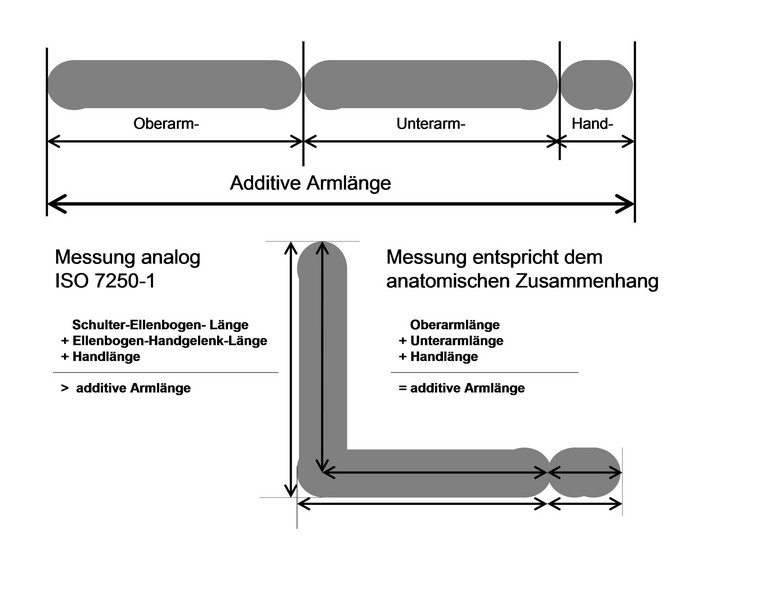Collections of anthropometric data often contain percentiles for dimensions of individual regions or parts of the body. For physiological/anatomical (see Movement) and measurement-related reasons, these percentiles cannot always simply be combined or added together. The summation of discrete percentile values is however also problematic for statistical reasons, owing to how percentiles are formed (see How are percentiles used?).
The additive arm length is equal to the sum of the individual dimensions for the upper arm length, forearm length and hand length only when the individual dimensions correspond to the anatomical relationship, i.e. when a corresponding landmark is located "in the joint" between two bones. The ergonomically relevant discrete dimensions of the shoulder-elbow length, elbow-wrist length and hand length, as stated for example in EN ISO 7250-1, yield a greater additive arm length than is the case in practice (see image below).

It has already been pointed out in How are percentiles used? that owing to the differences in proportions, the combining of percentile values of different body dimensions (height and breadth dimensions), for example in order to determine the dimensions of a very tall person, leads to errors. Owing to the differences in proportions of the human body, the combining of length dimensions is also subject to limitations, as demonstrated by the example in the table below.
| P5 | P50 | P95 | |
|---|---|---|---|
| Height | 1607 | 1715 | 1825 |
| Height sitting | 846 | 904 | 958 |
| Leg length | 742 | 812 | 886 |
| Calculated body height → incorrect | 1588 | 1716 | 1844 |
The leg length used in this case is normally calculated for each individual as the difference between the measured body height and height sitting (trunk length + head height).
If the values of the 95th percentile for the height sitting and leg length are added together to produce the 95th percentile for the body height, the result (1,844 mm) is higher than the value actually measured for this percentile, namely 1,825 mm. The difference between the measured and calculated values for the 5th percentile is in the same magnitude, at approximately 20 mm. This can be attributed to the phenomenon of "seated giants" and "seated dwarfs", i.e. to differences in body proportions. Short persons tend to have shorter legs, but not a shorter trunk ("seated giants"). Tall persons tend to have longer legs, but not necessarily a longer trunk ("seated dwarfs") (see Warning: Do not simply combine percentiles.).